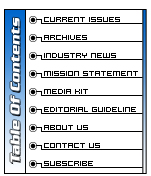|
Feedback Roland,
As always, I read your column, "An Industry Holds Its Breath" with great interest. However, your conclusion that the GeoTechnologies industry desperately needs a success ignores the reality... it already has one. The well publicized failure of yet another commercial imaging satellite, Space Imaging's IKONOS 1, is unfortunate. But its potential product, 1-meter panchromatic digital imagery, has been available in full color or color infrared throughout North America since 1997. While 1m commercial satellites will certainly add options for imagery users in the near future, nothing prevents the GeoTechnologies industry from aggressively exploiting airborne digital data that has been available for several years.
The LITTON/TASC Emerge Spatial Service is providing geo-referenced imagery (to National Map accuracy without ground control) covering thousands of sites for hundreds of clients. There are currently 8 aircraft equipped with the LITTON/TASC Emerge sensor based and operating throughout the US, with more planned to meet growing demand. One is flying 6-inch resolution, full color coverage over Denver as I write this letter. Last year, TASC Emerge projects covered 44 of the contiguous 48 states. We don't plan to let any state, including Alaska and Hawaii, go unimaged. For the GeoTechnologies industry to tread water until someone successfully launches a 1m satellite is absurd. Imagery to develop the geo-referenced 1m and better resolution market is available today. Aircraft taking off daily from airports throughout the country to image client projects admittedly lack the media interest that accompanies a satellite launch. However, it is noteworthy that shortly after the loss of IKONOS 1, Space Imaging announced an airborne imaging service.
It is not my intent to in any way belittle the tremendous investment and potential of the commercial high-resoultion satellites. But, your column creates the impression to many prospective users and GeoTechnology vendors that, for some reason, they must wait for the benefits of satellite technology to arrive. When in fact, for areas of the world having a well developed aviation infrastructure, such as North America, sophisticated image products collected by aircraft have been available for years at prices frequently much lower than those announced by firms planning to offer satellite coverage. Prospective users can join the thousands of clients familiar with and benefiting from the use of digital, geo-referenced airborne imagery to conduct their daily operations more efficiently. With the tremendous hype accompanying satellite endeavors, I believe you have let this quiet success go unnoticed.
Al Stringham, President
Landcare Aviation, Inc.
Oneida County Airport
Orinsky, NY 13424 Tel: 315-736-4225
Dear X. Long Dai,
Your article on Roadway Feature Extraction in the May 1999 issue of EOM states: "At present, the cost of satellite digital imagery is around US$5/km2 for a single scene with 10m resolution. The covered area can vary from 50km2 to 500km2."
Please note that a SPOT 10m image sells for $1,950 and covers a 60x60 km area (3,600km2). Therefore, it is only $0.54/km2. Your statement, at least with respect to SPOT, appears to be off by almost one order of magnitude.
Regards, John McKeon
Account Manager, Resources West
SPOT Image Corporation
Tel: 972-267-0553
Fax: 972-267-0554
E-mail: [email protected]
Web: www.spot.com Dear John,
Thank you for reading our article. That number is a type-o. Sorry for the error.
Best regards,
X. Long Dai
Back
|



